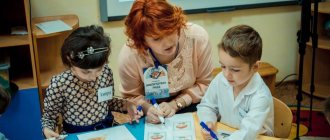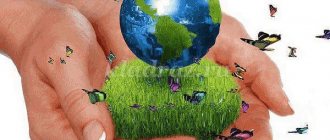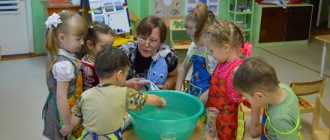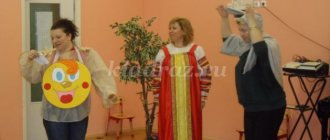MAGAZINE Preschooler.RF
Cognitive and research project in the junior group Topic: “We are little researchers”(long-term, practical-experimental)
Author of the project: teacher Shekunova O.V. MDOU Kindergarten No. 54 “Firebird” Moscow region, Podolsk
“The more a child has seen, heard and experienced, the more he knows and assimilated, the more elements of reality he has in his experience, the more significant and productive under other conditions his creative and research activity will be.” Lev Semenovich Vygotsky
Project Description
Experimentation is an effective method of understanding the patterns and phenomena of the surrounding world. Children's experimentation has enormous developmental potential. Modern children live in the era of informatization and computerization. In a rapidly changing life, a person is required not only to possess knowledge, but also, first of all, to be able to obtain this knowledge himself, operate with it, think independently, creatively.
All researchers of experimentation highlight the main feature of the cognitive activity of children: the child learns an object in the course of practical activities with it, the practical actions carried out by the child perform a cognitive, orientation-exploratory function, creating conditions in which the content of this object is revealed. In everyday life, children often experiment with various substances themselves, trying to learn something new. They disassemble toys, watch objects falling into the water (drowning or not drowning), testing metal objects with their tongues in severe frost, etc. But the danger of such “amateur activities” lies in the fact that the preschooler is not yet familiar with the laws of mixing substances and basic safety rules. An experiment, an experience specially organized by a teacher, is safe for the child and at the same time introduces him to the various properties of surrounding objects, the laws of life of nature and the need to take them into account in his own life.
Experimentation permeates all areas of children's activity. A preschool child is a researcher in himself, showing a keen interest in various types of research activities - in experimentation. Experiments help develop a child’s thinking, logic, and creativity, and allow them to clearly show the connections between living and nonliving things in nature.
This project represents the creation in a group of conditions for the development of cognitive activity in children and the formation in children of interest in the study of inanimate and living nature through children's experimentation. In the process of experimental activities, the following types of activities are used:
- gaming
- cognitive - research (experiments) and productive
— communicative (conversations, reading fiction)
All conversations and experiments are conducted taking into account the level of development and cognitive interests of children.
Work with children of this age group is aimed at creating the conditions necessary for sensory development during familiarization with the phenomena and objects of the surrounding world.
Relevance of the project
Childhood is a special period of formation of organs and systems and, above all, brain function, a period of active experimentation of the child with the objective world, without which the normal formation of the child’s mental abilities is impossible.
Everything that surrounds the baby - things that belong to adults, toys, animals, plants, water, sand and much more - arouses his interest.
He loves to explore new objects, experiment with various substances and materials: water, sand, snow, clay, paints, etc.
At the age of 3 years, children cannot yet operate with knowledge in verbal form, without relying on visual evidence, so in the vast majority of cases they do not understand the explanations of an adult and strive to establish all the connections on their own, through experiences and experiments.
Therefore, for children of this age, experimentation, along with play, is a leading activity. To do this, it is necessary to organize the work in such a way that children can repeat the experience shown to adults, they can observe, answer questions using the results of the experiments. In this form, the child masters experimentation as a type of activity and his actions are reproductive in nature.
Project object: formation of cognitive and research development, social and communicative development; speech development.
Project duration: November 2022 – June 2022
Project participants: children of primary preschool age, teachers, parents.
All experiments take place with the participation of game characters
Project goals:
- Development of ideas about the properties of substances, phenomena of the surrounding reality (water and air, light and shadow, magnetism, properties of sand, clay, stone, wood, plastic, metal and fabric); about the interaction of various substances when they are combined, about the influence of some objects on the properties of others.
Project objectives:
- Expand children's understanding of the physical properties of the world around them;
- Introduce the various properties of substances (hardness, softness, flowability, viscosity, buoyancy, solubility.);
- Develop children's understanding of certain environmental factors;
- Expand the understanding of human use of environmental factors: sun, earth, air, water, plants;
- Expand children's understanding of the importance of water and air in human life;
- Introduce children to the properties of soil and its constituent sand and clay;
- Develop an emotional and value-based attitude towards the world around you;
- To develop the intellectual emotions of children: to create conditions for the emergence of surprise in relation to observed phenomena, for awakening interest in solving assigned problems, for reflection, for the opportunity to rejoice at the discovery made.
Expected results:
- Bring children to a higher level of cognitive activity;
- To build self-confidence in children through the development of mental operations, creative prerequisites and, as a result, the development of personal growth and a sense of self-confidence and self-confidence in children;
- Enrich the subject-development environment in the group; To replenish the scientific and methodological base of the preschool educational institution in this area of work.
Stages:
1. Preparatory.
- Setting the goals and objectives of the project
- Determining the relevance and significance of the project
- Selection of methodological literature on the topic of children's experimentation in kindergarten and at home, for the implementation of the project (magazines, articles, abstracts)
- Development of long-term planning for experimental activities in the second junior group for the project “We are little researchers”
- Development of a plan for interaction with parents on experimental activities in the junior group for the project “We are little researchers”
- Selection of fiction for children
- Selection of didactic, role-playing and outdoor games on the topic.
2. Basic.
- Creation and arrangement of experimentation for successful project implementation
- Implementation of experimental activities with children on long-term planning
- Lesson planning, applications, working with parents.
3. Final.
- Create a subject-based development environment for children to independently experiment with natural and waste materials.
- Making a file cabinet for experimental activities with children
preschool age by age category
- Photo collage for parents
- Publication on educators' websites.
: containers of different sizes, measuring cups, cups, spoons, watering cans, molds, pebbles, sand, water, straws, soap, cocktail straws, funnels, objects made of different materials (wooden spools, rubber balls, toys, plastic buttons, metal objects etc.), plastic cups of different shapes, sizes, degrees of transparency.
: strings, plastic bags, balloons, pinwheels, kites, plumes, ribbons, flags, weather vanes, parachute.
Materials and equipment:
Magnifying glasses, a spoon, dishes, a toy, a box with fabric of different textures, characters in clothes made of paper and fabric, scraps of fabric, paper, ropes, rulers, an hourglass, a globe, a lamp, a flashlight, whisks, beaters, soap, brushes, sponges, pipettes, small things made of various materials (wood, plastic, metal), mills, corks, fluff and feathers, multi-colored clothespins; pebbles of different sizes
Containers: plastic jars, bottles, glasses of various shapes, sizes, measures, funnels, sieve, molds, spatulas.
Materials: natural (acorns, cones, seeds, shells, twigs, saw cuts, cereals, etc.), “waste” (corks, sticks, pieces of rubber hoses, cocktail straws, etc.), bean seeds, beans , peas; nut pits and shells; cotton wool, batting, padding polyester
Unstructured materials: sand, water, sawdust, wood shavings, fallen leaves, etc.
Forms of working with children:
Didactic games:
- "Find a Pair"
- "Find out the subject"
- "Taste it"
- "Find out by touch"
- "Recognize the sound"
Plot-role-playing games:
- "Laboratory"
- "Wind and Leaves"
- Game - experiment "Drawers"
Board-printed games:
- "Seasons"
- "Natural Phenomena"
- "What happens in nature"
- Cutting pictures “Collect plants”
- “What grows where?”
- Lotto "Flowers"
- "Signs of autumn, winter, spring, summer"
Outdoor games:
- "Sun and Rain"
- "Bubble"
- "My funny ringing ball"
- "What's hidden?"
- "Bumps"
Finger games
- “Rain” (Russian folk nursery rhyme)
- Oh you, rainbow-arc... (Russian folk nursery rhyme)
- "Snowball"
- "Sun"
- "Autumn leaves"
- "Ball"
- "Leaf Fall"
- "Snowflakes"
- “What to do after the rain?”
- "Rain"
- "EXERCISE WITH CORKS"
Poems and riddles about living and inanimate nature
The implementation of the set tasks is fully possible only if there is close interaction with the parents of the children.
Interaction with parents on basic experimentation:
Involving parents in replenishing attributes and materials.
Consultation:
“Organization of children's experimentation at home” , “Experimental activities in kindergarten. . " "Organization of children's experimentation at home" .
Memos for parents:
“Children's experimentation” , “What is possible and what is not” , “Signs of cognitive activity” , “On the organization of cognitive and research activities” “experimenting with water” and consultation for parents
Making a card index for visual propaganda of parents to conduct experiments and experiments with children at home.
Literature and sources
- E.A. Martynova, I.M. Suchkova. Organization of experimental activities for children 2-7 years old. Volgograd, 3rd edition, 2012
- O.V. Dybina, N.P. Razmanova, V.V. Shchetinina. “The unknown is near. Entertaining experiences and experiments for preschoolers . Moscow, 2005
- Internet resources.
- Nikolaeva S. N. “Methods of environmental education in kindergarten . – M. 2022
- Dybina O. V. “Classes on familiarization with the outside world in the second junior group of kindergarten” M.: Mozaika - Synthesis, 2014 (methodological manual)
- Experiences and experiments with substances and materials 3-4 years Federal State Educational Standard for Education. Card planning in preschool educational institutions.
| Next > |
Goals:
- Conversation with children to identify children's knowledge about winter natural phenomena.
- Discussion of the topic, determination of goals and objectives of the project.
- Organization of subject-development environment.
- A selection of literature, games, experiments, illustrations.
- Discussion with parents about upcoming events.
Results of the stage: The direction of children’s interest was identified, and, as a result, a plan for further action.
II . Meaningful.
1 day.
Conversation “What is snow.”
Goal: To form a concept about snow, where it comes from.
Didactic game “When does this happen?”
Goal: Continue to develop knowledge about the seasons, their sequence and changes in nature.
Drawing "Snowman".
Goal: Development of children's spatial imagination through drawing an object consisting of several parts.
Day 2.
ECD for speech development “Winter Walk”.
Goal: To teach children to write a story based on a picture.
- behind the snowfall.
Goal: To form children’s ideas about a seasonal phenomenon - snowfall.
Experiment No. 1 “Snow and its properties”
Purpose: To introduce children to the physical properties of snow - it is white, cold, fluffy, and crumbles. When it is wet, you can sculpt from it.
Day 3.
Outdoor game “Snowflakes are spinning.”
Goal: Coordination of movement with the text of the poem.
Experiment No. 2 “Where did the snow hide?”
Goal: Show children that snow melts in warmth and turns into water.
Experience No. 3. "Determination of snow purity."
Purpose: Show children that snow can be dirty and should not be eaten.
Reading fiction “The Snow Maiden”
Goal: To introduce children to the Russian folk tale “The Snow Maiden”.
Day 4
Conversation “Why you can’t eat snow.”
Goal: developing the foundations of safe behavior and a healthy lifestyle.
- on sculpting "Snowman".
Goal: to teach children to name the main signs of the winter period, to consolidate the ability to sculpt a snowman from plasticine; divide the plasticine into three different parts, roll three balls (large, medium and small); develop independence.
- No. 4 “Multi-colored snow.”
Goal: Show children that snow can be painted.
Day 5
Design of a photo exhibition about the stages of the project.
Entertainment “Winter brought a lot of snow.”
Stage III. Final-analytical (summarizing)
The result of the event was the entertainment “Winter Brought a Lot of Snow,” in which children consolidated their knowledge of the properties of snow. In the reception area, a photo report of the project participants and the collective work “City in the Snow” were prepared.
Stage result:
Children have developed basic research skills and knowledge about the properties of snow.
As part of the project, it was possible to evoke in children positive emotions from joint communication with adults and peers, the joy of reading works of art and experiments.
Parents became more active and began to take part in joint activities on the project.
Research activities in kindergarten
Research activity in kindergarten is a special type of intellectual and creative activity based on search activity and research behavior; - this is a child’s activity aimed at understanding the structure of things, the connections between the phenomena of the surrounding world, their ordering and systematization.
Lesson on cognitive and research activities in kindergarten. Cognitive and research activity is one of the spontaneous manifestations of a child’s curiosity. This quality of an inquisitive mind needs to be actively involved in a variety of classes: studying the world around us, productive ones (drawing, modeling, designing), preparing to learn to read and write, etc.
The basis of research activity is: Search activity is behavior aimed at changing a situation (or attitude towards it) in the absence of a definite forecast of its results, but with constant consideration of the degree of its effectiveness.
In the section of the site, research activities in kindergarten for different groups contain many interesting publications for educators on teaching children on various topics:
- Cognitive research project in kindergarten
- Cognitive - research project
- Research project for older children in kindergarten
- Research work with children of the 2nd junior group
- Summary of educational and research lesson with children of the senior group
- Organization of research activities for preschool children
- Short-term creative and research project on environmental education for the younger group of kindergarten
- Development of children's horizons in cognitive and research activities in nature September, October, November
- Teacher Research Project
- Research creative project 2nd junior group
- Child research in preschool educational institutions as a teaching method
- Individual research project in kindergarten
- Search and research activities in the second junior group
- Research and creative project
- Summary of an open lesson in kindergarten on experimental research activities of older preschoolers
- Research activities in kindergarten
- Research project in kindergarten
- Research and creative project in the middle group
- Study of the influence of museum pedagogy on the development of creative abilities of children of senior preschool age
- Research in kindergarten on working with preschoolers
- Development of cognitive activity in children through search and research activities
Experimental research activities in kindergarten according to the Federal State Educational Standard. Experimental research activities in kindergarten. Pedagogical technology is a system of functioning of all components of the pedagogical process built on a scientific basis, programmed in time and space, and leading to the intended results. Among the pedagogical technologies that are used in working with preschool children, research technology is distinguished.
Design and research activities occupy a strong place in the work of our kindergarten. It has become an interesting and exciting process for both children and adults. Project activity is a conscious, reflective acquisition of new knowledge; it reveals creative abilities, which, in turn, are successfully developed during independent search.
Cognitive and research activities are leading from the first year of a child’s life. It realizes not only the development goals of children, but also their interests. Thanks to cognitive and research activities, the child’s creative potential and his need for new knowledge are realized, the prerequisites for educational qualities are formed, and personal qualities such as independence, initiative, creativity, and determination are developed. Respect is a necessary element in the community that the kindergarten group is. Educators set the example of mutual understanding, respect and care for each other that they expect from children.
Educational project. Second junior group
Educational project in the second junior group on the topic “Prickly hedgehog”
Author
Filina Kira Nikolaevna, teacher of the State Budgetary Educational Institution Child Development Center - kindergarten No. 49, Kolpinsky district of St. Petersburg
Description of material
I offer you an educational project for children of the second junior group (3-4 years old) on the topic: “Prickly hedgehog.” This material will be useful for teachers of younger groups to maintain the interest of younger preschoolers in project activities. A special feature of the project is that it was carried out during the adaptation period.
Information card of the project Project
duration : November 1-16 (two weeks) Project type : educational Project participants : preschool teachers, children of the second junior group, parents A significant problem for children, the solution of which the project is aimed at : “Why do I need to eat needles?” The goal of the project : the formation of a holistic picture of the world and broadening the horizons of children of primary preschool age. The result of the project : musical leisure “Little hedgehog, four legs...”.
Pedagogical intent of the project:
Educational area Cognitive development
Objectives: - to promote the development of cognitive and research activities of preschoolers;
- promote the development of creative thinking by solving a problem situation, imagination, tactile perception of children 3 years old; — create conditions for the formation of a motive for cognitive activity in children; — to consolidate preschoolers’ knowledge about the adaptability of hedgehogs to the environment. Educational field Speech development
Objectives: - to promote the expansion and activation of the vocabulary of children of primary preschool age; - create conditions for the development of coherent, grammatically correct dialogical and monologue speech.
Educational field Social and communicative development
Objectives: - improve game interaction skills; — to form in children a humane attitude towards living nature; — to develop a communicative culture among younger preschoolers; - create conditions for the development of the emotional sphere of each child.
Educational field Artistic and aesthetic development
Objectives: - contribute to the creation of prerequisites for the development of children's word creativity; — create conditions for the musical and motor development of children.
Educational field Physical development
Objectives: - to promote the development of verbal-motor coordination, small muscles of the hands.
Project content
Preparatory stage
(formulation of the problem, planning, forecasting the results / products of the project)
Objectives. To identify the level of children's knowledge about the life of hedgehogs. Create conditions for expanding and activating the vocabulary of younger preschoolers. Arouse interest among project participants in solving the problem. Actions of teachers Show images of hedgehogs; encourage children to compare with other forest animals. Organize discussions of a problematic issue. They invite children to fantasize about if hedgehogs didn’t have spines. Give recommendations to parents. Children's actions Look at illustrations with images of different hedgehogs. They ask the question: “Why does a hedgehog need needles?” They discuss and express their point of view. Under the guidance of the teacher, they decide to check the correctness of their answers. Actions of family members Together with their children, parents look at illustrative material depicting hedgehogs.
Activity stage
(direct project activities, phased assessment)
Objectives. Clarify and expand children's ideas about hedgehogs. Promote the development of coherent speech in preschoolers. Create conditions for the development of mental operations, memory, imagination, perception. Actions of teachers When discussing, encourage children to choose the most correct answer. Discuss with the children where they can check the correct answer to the question. Together with the children, they look at books about forest animals and search for information about hedgehogs. Involve parents in helping children find the correct answer. Help children write a descriptive story. Actions of children Children give their answers to the question: “Why does a hedgehog need needles?” Children who find it difficult to answer, at the request of the teacher, choose the correct answer from the answers of other children from their point of view. Discuss which sources can be used to check the correctness of the answer. Under the guidance of a teacher, they look for information about hedgehogs in the books available in the book corner. They are looking for a home with their parents. Family Actions Parents help children answer the question by finding available information.
Final stage
(presentation of project products and reflection - reflection on new knowledge or experience)
Tasks. Promote the development of creative abilities in preschoolers. Maintain independence in various activities. Increase the degree of socialization of the individual. Actions of teachers Organize a presentation of children's work for parents. After the presentation, place the children's work in the group's developmental environment. Organize a discussion of new knowledge; conversation about dangerous “prickly” objects. Children's actions Show their work to parents; talk about how they were performed. Consolidate new knowledge about hedgehogs under the guidance of a teacher; about the rules of behavior in the forest. Actions of family members Parents get acquainted with the products of children's activities.
Interaction with parents
— Announcement of the start of the project, regular updates on the progress of the project.
— Recommendations for introducing children to the life of hedgehogs — Individual thematic consultations — Exhibition of joint works “Hedgehogs are so different…” — Information materials for parents: “Family walks,” “We are going to the museum,” “Man-made hedgehogs.” — Assisting educators in the selection of materials for the successful implementation of the project (card index of poems, riddles, songs..., thematic selection of books and toys, organization of “Shelves of prickly objects”) Final event : musical leisure “Little hedgehog, four legs.”
We recommend watching:
A pedagogical project in the junior and middle groups of a preschool educational institution. A research project in a preparatory group. A project in a kindergarten for older preschoolers 5-7 years old on legal topics. Classes with older preschoolers 5-7 years old. One day project
Similar articles:
Development of communication skills in design and research activities in preschoolers
Educational and creative project on the theme “Golden Autumn”. Junior group
Project for children of the senior group “Our cheerful garden”



